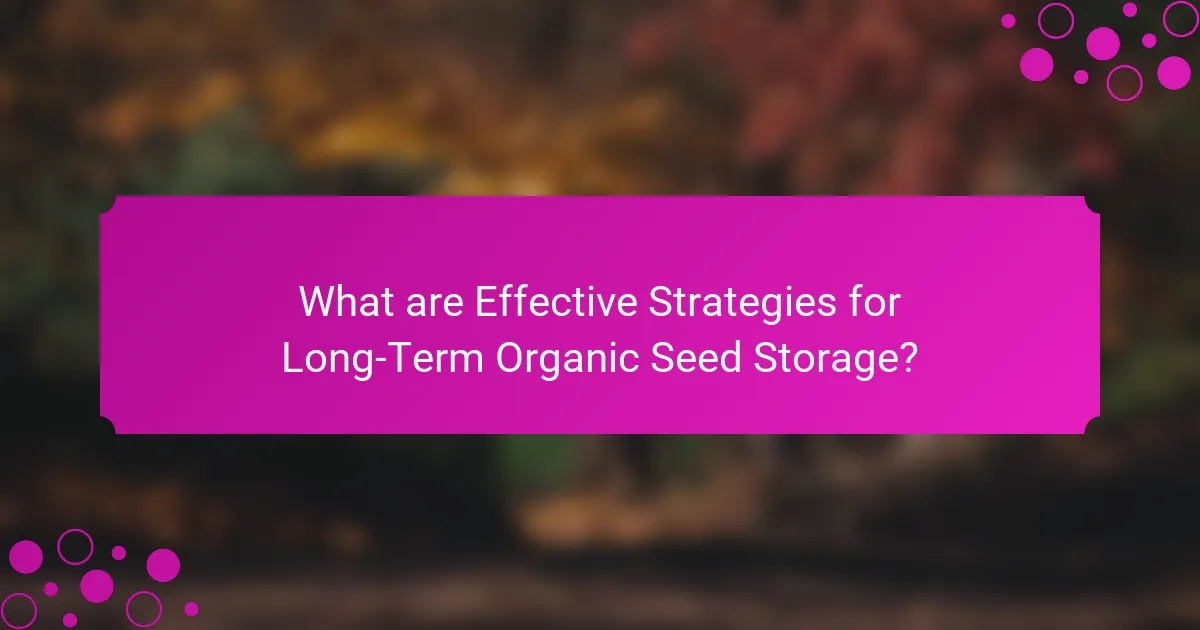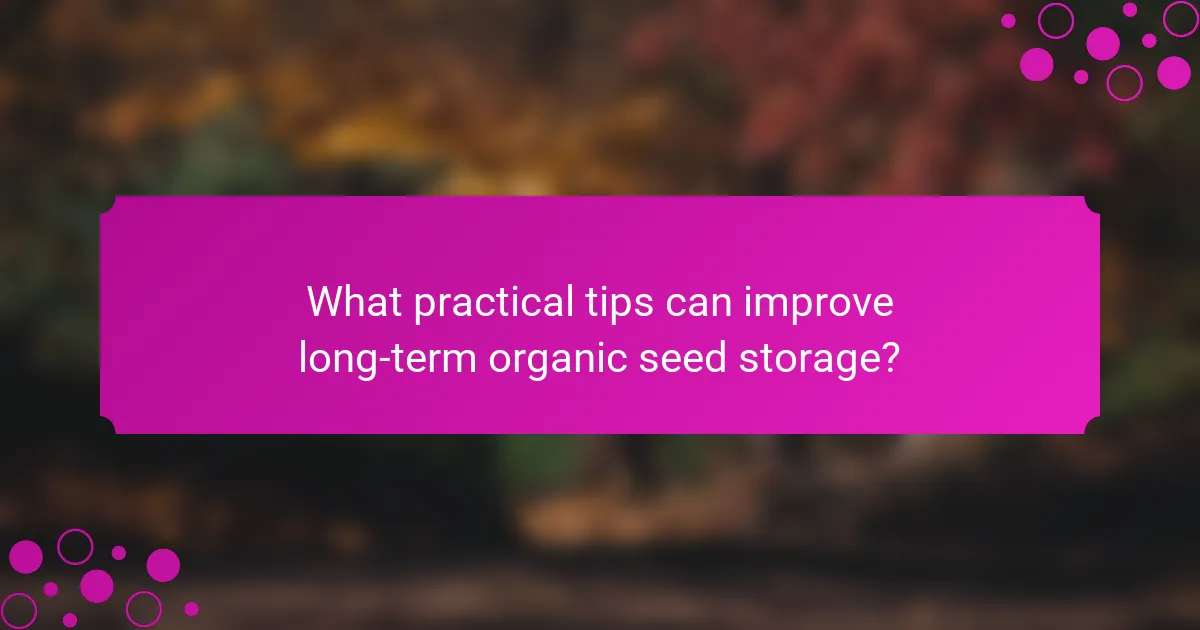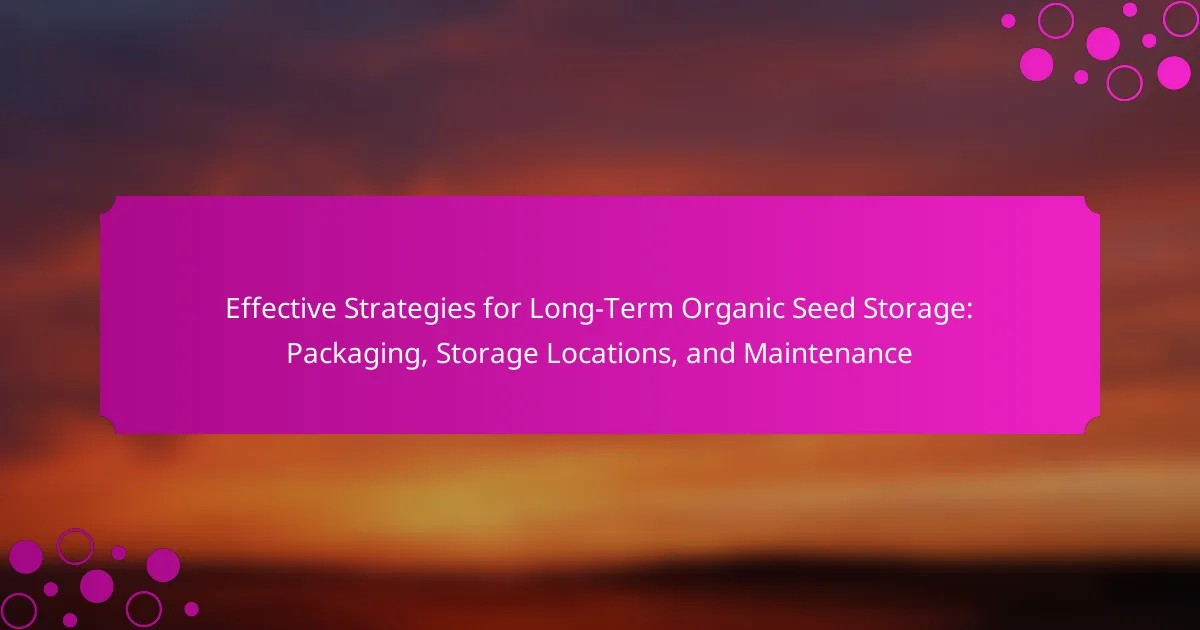Effective strategies for long-term organic seed storage focus on three main aspects: packaging, storage locations, and maintenance. Proper packaging involves using airtight containers such as glass jars or vacuum-sealed bags to prevent moisture exposure. Ideal storage locations are cool, dark, and dry, with temperatures maintained between 32°F to 41°F (0°C to 5°C) and humidity levels below 20%. Regular maintenance includes checking for spoilage, labeling containers with seed type and storage date, and conducting germination tests to ensure seed viability. Implementing these strategies can significantly enhance seed longevity and improve germination rates.

What are Effective Strategies for Long-Term Organic Seed Storage?
Effective strategies for long-term organic seed storage include proper packaging, ideal storage locations, and regular maintenance. Seeds should be stored in airtight containers to prevent moisture exposure. Glass jars, vacuum-sealed bags, or Mylar bags are recommended for this purpose. The ideal storage location is cool, dark, and dry. A temperature range of 32°F to 41°F (0°C to 5°C) is optimal. Humidity levels should be kept below 20% to ensure seed viability. Regular checks for signs of spoilage or pests are essential for maintenance. Labeling containers with seed type and storage date aids in organization. Following these strategies can significantly extend seed longevity and germination rates.
How does proper seed storage impact seed viability?
Proper seed storage significantly enhances seed viability. Viability refers to the ability of seeds to germinate and grow into healthy plants. Factors such as temperature, humidity, and light exposure directly influence seed longevity. Optimal storage conditions typically involve cool, dry, and dark environments. For instance, seeds stored at lower temperatures, around 32°F to 41°F, can maintain viability for several years longer than those kept at room temperature. Research shows that high humidity levels can lead to mold growth, reducing seed viability. Additionally, airtight containers can prevent moisture infiltration, further preserving seed health. Thus, proper seed storage practices are essential for ensuring that seeds remain viable for planting.
What factors influence seed longevity in storage?
Seed longevity in storage is influenced by moisture content, temperature, and light exposure. Low moisture levels are crucial for prolonging seed viability. Seeds stored in dry conditions can last significantly longer than those with higher moisture. Ideal storage temperatures are typically cool, around 32°F to 41°F (0°C to 5°C). Higher temperatures can accelerate aging processes. Light exposure can also degrade seed quality, making opaque containers preferable. Additionally, seed type plays a role; some seeds naturally have longer shelf lives than others. Proper packaging, such as airtight containers, further aids in maintaining seed longevity.
How do environmental conditions affect seed preservation?
Environmental conditions significantly impact seed preservation. Factors such as temperature, humidity, and light exposure affect seed viability. High temperatures can accelerate seed aging and reduce germination rates. Excessive humidity leads to mold growth and seed deterioration. Conversely, low humidity can cause seeds to dry out and lose viability. Proper storage conditions, ideally cool and dry, enhance seed longevity. Research indicates that seeds stored at 5°C and low humidity can maintain viability for decades. Therefore, controlling environmental conditions is crucial for effective seed preservation.
Why is packaging important for seed storage?
Packaging is important for seed storage because it protects seeds from environmental factors. Proper packaging prevents moisture, light, and pests from damaging seeds. Seeds stored in airtight containers can maintain their viability for longer periods. The right packaging material can also minimize the risk of contamination. For instance, using breathable bags can help control humidity levels. Research indicates that seeds can lose viability quickly when exposed to unfavorable conditions. Effective packaging ensures that seeds remain viable for planting in future seasons.
What types of packaging materials are best for organic seeds?
The best types of packaging materials for organic seeds are breathable paper bags, glass jars, and biodegradable containers. Breathable paper bags allow moisture control and prevent mold growth. Glass jars offer airtight sealing, protecting seeds from humidity and pests. Biodegradable containers are eco-friendly and provide a natural environment for seed storage. These materials help maintain seed viability by preventing exposure to light and moisture. Research shows that proper packaging can extend seed life by several years.
How can packaging design enhance seed protection?
Packaging design enhances seed protection by providing a barrier against environmental factors. Effective packaging materials prevent moisture, light, and pests from damaging seeds. Airtight containers can reduce humidity, which is crucial for seed longevity. UV-resistant materials protect seeds from harmful light exposure. Additionally, sturdy packaging prevents physical damage during transport and storage. Research indicates that seeds stored in optimal packaging can maintain viability for several years. A study by the Seed Savers Exchange shows that proper packaging can extend seed life by up to 50%.
What are the best storage locations for seeds?
The best storage locations for seeds are cool, dark, and dry environments. Ideal locations include a refrigerator, a basement, or a climate-controlled room. These areas maintain stable temperatures and humidity levels. Seeds stored in cool conditions can last longer without losing viability. A temperature range of 32°F to 41°F is optimal. Humidity should be kept below 20% to prevent mold growth. Using airtight containers enhances protection from moisture and pests. Properly stored seeds can remain viable for several years.
How does temperature affect seed storage locations?
Temperature significantly affects seed storage locations by influencing seed viability and longevity. Higher temperatures can accelerate seed deterioration and reduce germination rates. Ideal seed storage temperatures typically range from 32°F to 41°F (0°C to 5°C). At these temperatures, seeds can remain viable for several years. Conversely, temperatures above 86°F (30°C) can lead to rapid loss of seed quality. Humidity also plays a role, as warmer temperatures can increase moisture levels, further compromising seed integrity. Research shows that maintaining optimal temperature and humidity levels can extend the shelf life of seeds significantly.
What role does humidity play in seed storage environments?
Humidity plays a critical role in seed storage environments. It affects seed viability and longevity. High humidity can lead to seed moisture absorption. This can cause mold growth and seed deterioration. Conversely, low humidity can prevent moisture-related issues. However, excessively low humidity can also harm seeds by causing them to dry out. The optimal humidity level for seed storage is typically between 20-30%. This range helps maintain seed viability while preventing spoilage. Studies show that controlling humidity can extend seed lifespan significantly. For example, seeds stored at optimal humidity can remain viable for several years.
How can maintenance practices extend seed shelf life?
Maintenance practices can significantly extend seed shelf life by ensuring optimal storage conditions. Proper temperature control is essential; seeds should be kept in a cool, dry place. Humidity levels must be monitored to prevent mold and deterioration. Regularly checking for pests can protect seeds from damage. Using airtight containers can reduce exposure to moisture and air. Labeling containers with dates helps track seed viability over time. Additionally, rotating older seeds to the front ensures they are used first. These practices maintain seed quality and viability, ultimately prolonging shelf life.
What routine checks should be performed on stored seeds?
Routine checks on stored seeds include assessing moisture levels, inspecting for pests, and evaluating seed viability. Moisture levels should ideally be below 8% to prevent mold growth. Use a moisture meter for accurate readings. Inspect seeds for signs of insect activity or damage regularly. This helps ensure seed integrity. Conduct germination tests to evaluate viability every few years. A simple test involves planting a sample in soil and monitoring growth. Document findings to track seed health over time. Proper maintenance of storage conditions also contributes to seed longevity.
How can pests and diseases be managed in seed storage?
Pests and diseases in seed storage can be managed through several effective strategies. Regular monitoring of stored seeds is essential to detect any signs of infestation early. Maintaining low humidity levels in storage areas helps prevent mold and mildew growth. Properly sealing seed containers can deter pests from accessing the seeds. Using natural repellents, such as diatomaceous earth, can provide an additional layer of protection against insects. Implementing a rotation system for stored seeds ensures older seeds are used first, reducing the risk of deterioration. Regular cleaning of storage facilities minimizes the presence of pests. According to the USDA, maintaining optimal storage conditions can significantly reduce seed loss due to pests and diseases.

What specific methods can enhance seed storage effectiveness?
Proper seed storage can be enhanced by controlling temperature, humidity, and light exposure. Maintaining a cool, dry environment is critical. Ideal temperatures range from 32°F to 41°F (0°C to 5°C). Humidity levels should be below 20% to prevent mold and decay. Using airtight containers can significantly reduce moisture exposure. Dark storage locations help minimize light degradation. Regularly checking seed viability through germination tests can ensure quality. Additionally, labeling containers with dates and seed types aids in inventory management. Research indicates that these methods collectively improve seed longevity and germination rates.
How can seed storage be optimized through organization?
Seed storage can be optimized through organization by implementing systematic categorization and labeling. Organizing seeds by species, variety, and planting date enhances accessibility. Use clear, durable containers for each category to prevent contamination. Label each container with relevant information, including germination rates and storage dates. Maintain a detailed inventory to track seed types and quantities. Regularly review and update the inventory to ensure seeds are used within their viability period. These practices improve efficiency and maintain seed quality during storage.
What labeling systems are most effective for seed storage?
The most effective labeling systems for seed storage include waterproof labels, color-coded systems, and digital tracking methods. Waterproof labels ensure that information remains intact despite moisture. Color-coded systems facilitate quick identification by grouping seeds based on type or planting season. Digital tracking methods utilize apps or spreadsheets to manage inventory and track germination rates. Research indicates that proper labeling significantly reduces seed mix-ups and enhances organization. A study published in the Journal of Seed Technology highlights that effective labeling can improve seed viability and accessibility.
How does inventory management contribute to seed health?
Inventory management contributes to seed health by ensuring optimal storage conditions and reducing spoilage. Proper inventory practices maintain appropriate temperature and humidity levels. This prevents seed deterioration and preserves viability over time. Regular monitoring of seed inventory identifies issues like pests or mold early. Effective tracking allows for timely usage of older seeds, minimizing waste. Data-driven decisions help in adjusting storage methods based on seed type and condition. Research shows that well-managed inventories can enhance germination rates significantly. For example, seeds stored under controlled conditions can retain viability for years compared to those poorly managed.
What innovative technologies are available for seed storage?
Innovative technologies for seed storage include controlled atmosphere storage, cryopreservation, and seed vaults. Controlled atmosphere storage regulates temperature and humidity to prolong seed viability. This method can extend the lifespan of seeds significantly, sometimes for decades. Cryopreservation involves freezing seeds at ultra-low temperatures to halt metabolic processes. This technique preserves genetic material effectively and is used for rare and endangered species. Seed vaults, like the Svalbard Global Seed Vault, provide a secure, long-term storage solution under optimal conditions. These facilities protect seeds from natural disasters and climate change impacts. Each of these technologies enhances seed preservation efforts globally.
How do moisture control systems work in seed storage?
Moisture control systems in seed storage regulate humidity levels to preserve seed viability. These systems typically use dehumidifiers, humidity sensors, and ventilation to maintain optimal conditions. Dehumidifiers extract excess moisture from the air, reducing the risk of mold and seed deterioration. Humidity sensors monitor moisture levels and provide real-time data for adjustments. Proper ventilation allows for air circulation, preventing moisture buildup. Maintaining humidity below 15% is crucial for long-term seed storage. Research indicates that seeds stored in low humidity conditions have higher germination rates compared to those in high humidity.
What are the benefits of using digital monitoring for seed conditions?
Digital monitoring for seed conditions enhances seed storage by providing real-time data on environmental factors. This technology allows for precise tracking of temperature and humidity levels. Maintaining optimal conditions is crucial for seed viability. Research indicates that seeds stored at correct temperatures can retain over 90% germination rates for extended periods. Digital monitoring systems can alert users to any deviations from set parameters. This proactive approach helps prevent seed spoilage and loss. Studies show that effective monitoring can extend seed longevity significantly. Overall, digital monitoring improves management efficiency and seed quality preservation.

What practical tips can improve long-term organic seed storage?
Store seeds in a cool, dry place. Ideal temperatures range from 32°F to 41°F (0°C to 5°C). Use airtight containers to protect seeds from moisture and pests. Glass jars or vacuum-sealed bags are effective options. Label each container with the seed type and date of storage. This helps in tracking seed viability. Monitor humidity levels; aim for less than 20% humidity. Use silica gel packets to absorb excess moisture if needed. Regularly check stored seeds for signs of mold or pests. Discard any compromised seeds to maintain overall quality.
How can gardeners ensure the best practices for seed storage?
Gardeners can ensure the best practices for seed storage by keeping seeds in a cool, dark, and dry environment. Ideal storage temperatures range between 32°F and 41°F (0°C to 5°C). Seeds should be placed in airtight containers to prevent moisture exposure. Using materials like glass jars or vacuum-sealed bags is effective. Labeling containers with the seed type and date of storage aids in organization. Regularly checking seeds for signs of mold or pests helps maintain their viability. According to the USDA, properly stored seeds can remain viable for several years.
What common mistakes should be avoided in seed storage?
Common mistakes to avoid in seed storage include using improper containers. Seed storage containers should be airtight to prevent moisture. Failure to label seeds accurately leads to confusion during planting. Storing seeds in light can degrade their viability over time. High humidity environments can cause seeds to mold or sprout prematurely. Keeping seeds in fluctuating temperatures can reduce their longevity. Lastly, neglecting to check seed viability regularly can result in planting non-viable seeds. These practices ensure seeds remain healthy and viable for future planting.
How can seasonal changes affect seed storage strategies?
Seasonal changes significantly impact seed storage strategies. Temperature and humidity fluctuations can affect seed viability. For example, higher temperatures can accelerate seed aging and reduce germination rates. Conversely, cooler temperatures can help preserve seeds for longer periods. Humidity levels also play a crucial role. High humidity can lead to mold and seed rot, while low humidity can cause seeds to dry out.
To adapt to seasonal changes, storage locations should be climate-controlled. This helps maintain consistent temperature and humidity levels. Additionally, using airtight containers can protect seeds from moisture and pests. Regular monitoring of storage conditions is essential to ensure seed quality is maintained. Research indicates that optimal storage conditions can extend seed longevity significantly, often by years.
Effective strategies for long-term organic seed storage encompass key aspects such as packaging, storage locations, and maintenance practices. Proper packaging methods, including airtight containers like glass jars and vacuum-sealed bags, are essential to prevent moisture and pest damage. Ideal storage conditions require cool, dark, and dry environments, with optimal temperatures between 32°F to 41°F and humidity levels below 20%. Regular maintenance checks for spoilage and pests, along with effective labeling and inventory management, further enhance seed viability and longevity. These comprehensive strategies collectively ensure that seeds remain healthy and viable for future planting.
